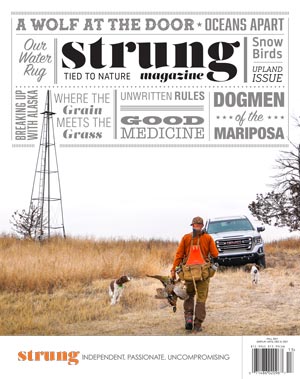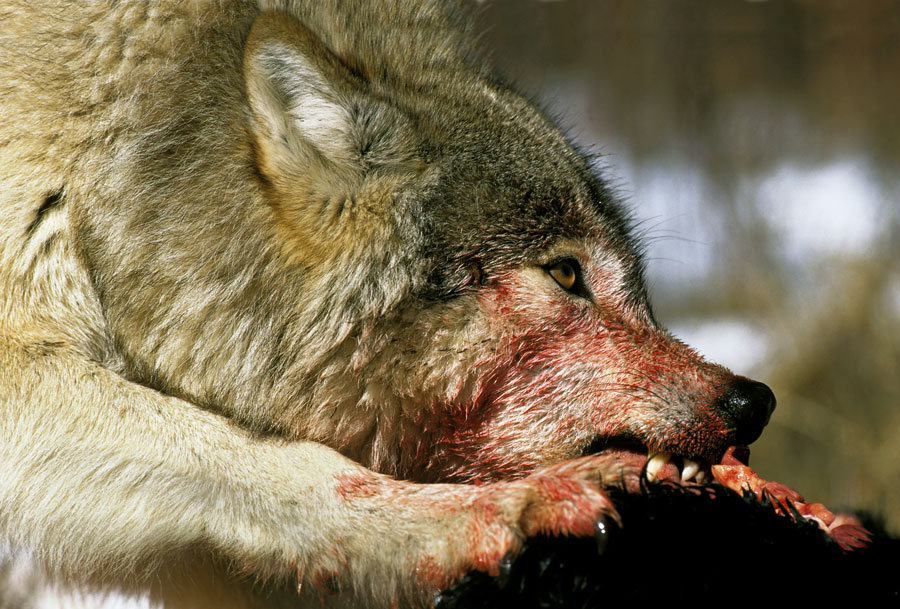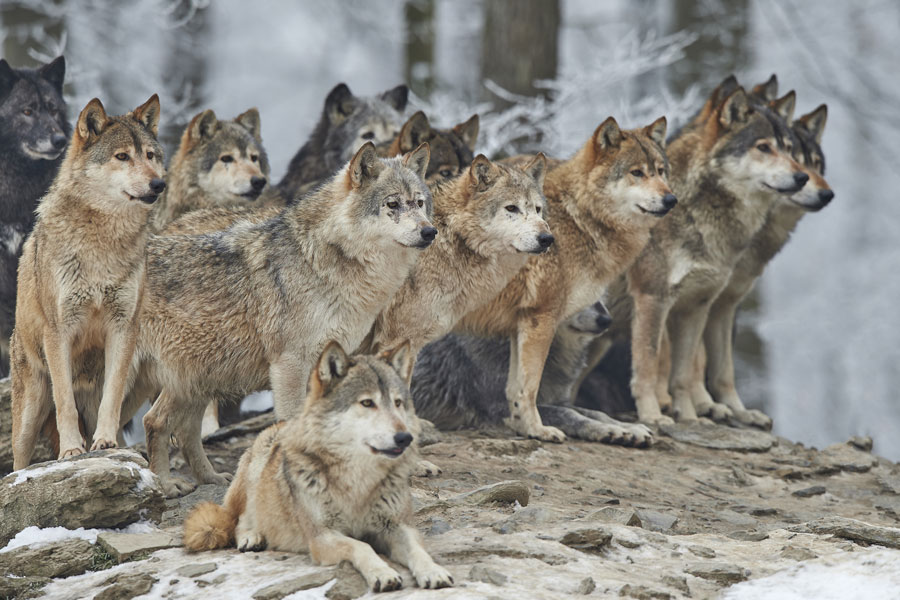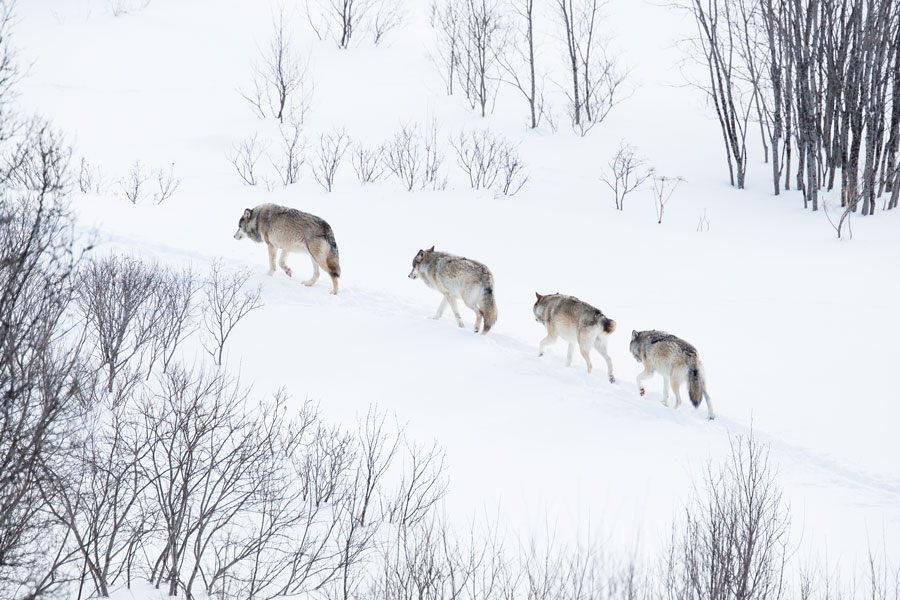by Reed Knappe
In all the animal kingdom, no species is more contradictory than the gray wolf (Canis lupus): divisive and celebrated, iconic but despised, persecuted yet undisputed sovereign over remote parts of the earth. No animals have caused more blood and ink to be spilled than wolves, where merely writing about them is an invitation to calumny. And nowhere on earth is the animal’s status—its very existence—more charged than in the United States, where the wolf issue melds animosities born on the historical frontier with the cynical polarities of contemporary politics. In November 2020, spurred on by an eleventh-hour nudge from the Trump Administration, the U.S. Fish and Wildlife Service (USFWS) officially removed wolves from the Endangered Species List. A culmination of decades of debate, the delisting drew fierce criticism from scientists and environmentalists, and it is quickly transforming how wolf populations are managed. The termination of protections marks a unique inflection point in the wolf’s history: a moment for asking hard questions about the human-wolf relationship and for revisiting old dilemmas.
Viewed from a certain distance, the change in legal status doesn’t change much: Wolf hunting has continued unabated for decades in Alaska and Canada, whose respective populations of 11,000 and 50,000 to 60,000 animals dwarf the lower 48’s estimated 6,000 gray wolves. Likewise in the Northern Rocky Mountains (Montana, Idaho, and Wyoming), where reintroduced wolves have thrived beyond expectations, the animals have been delisted and hunted intensively since 2011. Love it or hate it, the process of prying wolves away from Endangered Species protections has been underway for decades, without seeming to reverse a steady growth in wolf numbers. In immediate terms, delisting alters only the status of wolves in their most populous stronghold: the Western Great Lakes region (northern Minnesota, Wisconsin, and Michigan), where modest hunting seasons are now in the offing and where some three-quarters of (non-Alaskan) American wolves reside.
If, for the sake of argument, we set aside the wolf’s mystique and charisma (features not universally recognized anyway), there is a certain cold logic to arguments for delisting. The original conservation goals, dreamt up haphazardly in the early days of the Endangered Species Act (ESA, 1973), have been met and exceeded. Wolves have done better than anyone expected, both by recolonizing habitat from the Canadian side of the border and in a handful of successful reintroductions. Supporters of delisting point out that turning responsibility over to individual states will free up federal funding for more seriously threatened organisms. If wolves are no longer dying out, why not focus on species facing real extinction—and let states manage their own wolves? For delisting advocates, including many USFWS officials, doing so seems consistent with both the letter and spirit of the law.
Take a closer look at the wolf, however, and things get more complicated. Questions multiply, simple answers evaporate, and unplanned consequences start to unfold. The ESA, put in place as a legal mechanism for stemming the decline of American biodiversity, has always been an awkward fit for the wolf, a geographically diffuse top predator that once ruled over much of the continent. Most of the United States is former wolf habitat; how much of it can still sustain wolves? How much of it should? The ESA offers little concrete guidance on these questions, beyond the vague mission statement of protecting species “in danger of extinction throughout all or a significant portion of its range.” By 1973, after more than a century of vigorous extermination, the wolf was confined to two small, precarious populations on the Great Lakes—in other words, unambiguously endangered.
Today, however, that metapopulation is stable and growing, and wolves have an increased presence in the Northern Rockies and the Pacific Northwest. At the heart of the matter is the question of where (if anywhere) Americans are willing to let wolves expand and multiply—and buried within that, the deeper and still more intractable problem of how we understand the animal.
A certain kind of hunter won’t linger on these questions. To them, the wolf is only an exotic quarry—something to kill and mount as a trophy. Methodically gunning down a pack from a helicopter offers them a kind of unreflective thrill, not unlike playing out a video game or action movie in real life. I invite anyone who finds this caricature unfair to spend five minutes Googling trophy wolf hunts.
To another, more numerous brand of hunter, steeped in a particular relationship to the landscape and its animals, the wolf is something else: a menace to a cherished way of life. For such men and women, often the descendants of homesteaders, the notion of protecting or reintroducing wolves—undoing the hard bloody work of past generations—is madness. Their belief that wolves should be confined to a few wilderness redoubts or wiped out altogether is amazingly tenacious across the American West. (Sporting the silhouette of a wolf framed by crosshairs, a popular bumper sticker in Montana reads, “Smoke a Pack a Day.”) And the attitude has deep historical roots.
The historical frontier was a place of astonishing upheaval, and much of its spectacular violence was waged through and for control over the environment. The destruction of the great buffalo herds is broadly familiar to many Americans, but the related, century-long campaign against the wolf is less well known. Yet it was every bit as thorough as—and waged far more creatively than—what befell the American Bison. As it happens, states being recolonized by wolves today once hosted the most sophisticated and successful predator killing spree in history, sparked by an ecological collision course between settlers and wolves. In the classic account of human-wolf history, Of Wolves and Men, the late Barry Lopez traces the progress of wolf extermination from its earliest colonial roots through to the 1970s. As trappers and settlers entered the West, they slaughtered prey animals—buffalo, elk, moose, antelope, and deer—by the millions while bringing their own, more vulnerable beasts to multiply across the emptied land. The inevitable outcome was a virtual war between wolves and humans. First glutted on the countless carcasses of bison, then increasingly desperate as traditional prey disappeared, packs of wolves fell upon the settlers’ slow-moving, guileless livestock. Retribution was swift and merciless. The struggle reached its apex with the sheep and cattle boom that remade the intermountain West (roughly 1875 to 1895), when bounties were paid on hundreds of thousands of wolf pelts. Lopez, like many authors, acknowledges that early ranchers had no choice but to kill wolves, but the intensity and cruelty of the killing, and its continuation for decades and into regions far beyond the necessities of the ranching economy, have puzzled scholars and naturalists ever since. It is, arguably, the only planned extinction on record.
In these years of heroic conquest, wolves were inscribed in the Western mind as nemesis: cruel, gluttonous, indolent villains unworthy of a place in the natural world. They were shot, beaten to death, trapped, poisoned, burned, and tortured in countless ways, pursued into desolate reaches far from humans and livestock. As Lopez and others have recounted, the big predators came to function as a scapegoat for all the cruel hardships of life on the frontier: Brutal weather, disease, livestock rustling, market fluctuations, and poverty stalked the rancher, and the wolf paid in blood for the rancher’s misery. By the turn of the century, the animals were all but wiped out in the heart of the ranching empire, but state legislators continued doling out exorbitant bounties for a handful of lonely stragglers. By midcentury, they were gone.
While hostility to wolves is rooted in history and geography, handed down across generations of rural families, it is also colored by present-day politics: Rural communities have weathered the vagaries of economic globalization and the ebbing of traditional ways of life (chief among them ranching), and politicians have made good business out of harnessing their pain and frustration. For many in the intermountain West, the hated figures of autocratic feds, tree-hugging coastal elites, and wolves form a baleful triumvirate dedicated to the destruction of rural liberty and prosperity. An often-theatrical resistance to those forces has helped turn the Northern Rockies deep red in the last 30 years and cultivated a widespread, potent antipathy to wolves.
A turning point in this synthesis arrived with the wolf reintroductions of the mid ‘90s. In 1995 and 1996, the USFWS released two small populations of Canadian wolves: one in Yellowstone National Park and another in Idaho’s Frank Church River of No Return Wilderness. The projects were greeted with intense hostility by ranchers across the region, whose fear that the wolves would multiply were soon borne out. Protected for roughly 15 years in prime habitat, the reintroduced wolves quickly increased their numbers by an order of magnitude, expanding beyond the protected areas even before 2000. Their legal standing was ambiguous, however: A 1982 revision to the wolf’s ESA status had categorized any reintroduced populations as “experimental and nonessential,” paving the way for state management in the Rockies and ensuring that deliberations over ESA delisting considered only the larger, Western Great Lakes population. While the measure of recovery was thus pinned to the Eastern population, the consequences of last year’s delisting have come down most dramatically in the mountains.
The struggle to delist Rocky Mountain wolves got underway around 2000, finally succeeding in 2011 in Montana and Idaho (and a few years later in Wyoming). In the meantime, environmental organizations used the ESA to challenge the delistings, and when the region’s wolves were returned to state management it was agreed that states would abide by relatively restrained conservation plans—written in collaboration with the USFWS—that would preserve wolf numbers roughly at contemporary levels. In 2021, with the wolf now fully delisted, those management plans are dead letters, and Western politicians have already enacted a flurry of legislation to put the wolf back “in its place.” Common features of the new laws are expanded (or unlimited) hunting seasons, liberalization of hunting methods, and new versions of the old bounty systems. It is virtually impossible to eradicate wolves in significant numbers using traditional hunting methods, so all possible means are back on the table: unlimited bags; hunting from aircraft, snowmobiles, and ATVs; night vision; poison; baiting; and traps. The frenzy of legal restructuring has extended to adjacent states like Utah and South Dakota, where any wolf that strays over the state border may be shot on sight, putting a significant brake on recolonization of further habitat.
Most extreme among the laws passed so far is SB 1211, introduced by Idaho Governor Brad Little. The law mandates extermination of 90 percent of Idaho’s 1,500 wolves, drawing the population back down to the original reintroduction goal of 150 animals. Although opposed by the Idaho Fish and Game Commission and the USFWS, the bill passed the state house in May, with lawmakers citing the urgency of defending game populations (particularly elk) and Idaho’s ranchers from wolf depredations. These rationales, although grounded in historical memory, cannot withstand even casual scrutiny. On average, 118 livestock were killed by Idaho’s wolves each year between 2018 and 2020. Compared with the roughly 40,000 animals claimed annually by bad weather and disease, the deaths represent a tiny drop in the state’s 2.8 million livestock—certainly not enough to justify spending hundreds of thousands of taxpayer dollars on bounties. Moreover, unlike livestock killed by other predators or by weather, the USFWS compensates ranchers for half of the value of livestock that fall prey to wolves. In a further ironic wrinkle, strong scientific evidence suggests that killing wolves disrupts the ability of packs to coordinate in taking natural prey, leading directly to increased predation on livestock.
Likewise, claims that Idaho’s elk need protection from wolves are unsupported by basic facts: Idaho’s present population of 120,000 elk is significantly higher than it was when the wolves were reintroduced. As conservationists are fond of pointing out, all biological evidence suggests that wolves are good for ecosystems. Detailed studies conducted in Yellowstone over the past 20 years have produced overwhelming evidence that wolf predation culls diseased animals from the population (notably, individuals suffering from Chronic Wasting Disease) and disperses herds across the landscape in a way that benefits the health of the entire ecosystem. By the same token, wolves almost certainly make elk and other ungulates appear more scarce: more wary, less vocal, less concentrated, and less conspicuous along roadways. For hunters this can be a real frustration that is easily misconstrued as a decline in the target species.
While the most dramatic immediate impacts on wolf populations are certain to unfold in the Northern Rockies, the larger, foundational population in the Western Great Lakes also faces consequences from delisting. In Wisconsin, the most anti-wolf of the region’s states, this year’s trial hunting season ended in an uproar symptomatic of the contradictions at the heart of wolf management. In just three days this February, Wisconsin hunters killed some 216 wolves—nearly twice the 119 specified in the state plan. The federation of 11 Ojibwe tribes, which elected to forgo hunting its allotted 81 wolves on behalf of conservation, condemned the overkill and criticized the decision to open the hunt during breeding season. The wolves killed represented roughly 20 percent of Wisconsin’s total population—nearly double the proportion hunted in Canada or Alaska, and potentially a high enough rate to drive the population down significantly within a decade, if continued.
In some ways, the explosion of enthusiastic wolf killing since November is misleading. There are numerous examples of formerly anti-wolf individuals coming around to more nuanced positions, and communities where antagonism has given way to something else. In countless local instances, ranchers and rural folk have been instrumental in wolf conservation. And of course there are hunters who pursue the animals from a more thoughtful, respectful vantage point—hunters who insist that they value the existence of the wolf “in its place” and do not seek its ultimate destruction. Ask any gathering of interested parties to define that place, however, and responses quickly disintegrate into a babel of contradictory positions and recrimination. Nobody seems to have a clear or practical vision of where the line might be drawn, and this impasse hints at intractable tensions at the heart of the modern human-wolf relationship.
The matter of the wolf’s future in the United States boils down to questions of place, in two distinct but related ways. In the literal sense, Americans have yet to resolve the question of where the wolf belongs. Its range once encompassed much of the continent, but many of the wild landscapes that made up that habitat mosaic are gone—bulldozed into fields, highways, suburbs, and parklands of all kinds. By and large, the few big remaining tracts suitable for wolf recolonization are home to rural communities that are ambivalent about or hostile to the prospect of sharing fields and valleys with toothy, unpredictable neighbors. Which brings us to the second, more abstract sense of place: What place are we willing to give the wolf in the natural world, and in relation to our society?
Like humans, wolves are apex predators who kill to live, inscribing their supremacy all the way down the food chain. Though industrial meat production and tidy packaging conceal this reality from most consumers, it is something hunters and ranchers grasp intuitively. Unlike most humans (excepting those who fill their own freezers or otherwise contribute to maintaining healthy wildlife populations), wolves have an inborn capacity to make some ecosystems healthier and wilder. Also unlike humans, wolves cannot adapt the fulfillment of their metabolic needs or place themselves in a position to accommodate other living beings. They are at once too near to us and too alien, and the wages of this unhappy intimacy are historical cycles of cruel violence and burning hatred. The wolf’s removal from the Endangered Species List seems poised to set in motion another round of this dismal cycle.
To most hunters, hatred of the quarry is an unwelcome and unfamiliar feeling. The frequent metaphorical slippages aside, hunting is neither warfare nor extermination. When the killing of animals approaches those extremes, it becomes something else. Having read through reams of documents surrounding last year’s delisting and its consequences, I cannot escape the impression that recent shifts in wolf policy are motivated mainly by hatred of the animal—originating in the wolf’s challenge to the human prerogative of ruling over nature and perpetuated by profoundly cynical politics. The legislation being written in Idaho, Wyoming, and Montana reflects a desire to destroy the animal, or if that proves legally impracticable, to confine it in populations so small and remote as to be little more than open-air zoo exhibits. Personally, I would not hunt a wolf, but the issue at stake is not wolf hunting per se. The problem is what one might call exterminationism: an unquenchable hostility fed by a thousand fears and insults that have little or nothing to do with actual wolves. It is difficult, but worthwhile, to continue imagining new ways of transcending this attitude.
To hammer out a working relationship with the wolf, Americans may need to simultaneously embrace one kind of human supremacy and abdicate another. The first recognizes that we have transformed most of this continent into environments built around the satisfaction of human needs, and that having wolves alongside us—free roaming, intelligent predators capable of travelling hundreds of miles and adapting to diverse habitats—means making coherent decisions about where they live and taking tough steps to implement those decisions. If the ESA was a flawed instrument for defining the wolf’s present and future reality, we desperately need some kind of wolf-specific replacement: a coherent national policy. This sense of responsibility also entails working closely with rural communities, so that wolf management isn’t autocratic or indifferent to local concerns. The second kind of supremacy—the older, biblical variety, which insists man must have perfect, absolute dominion over all the earth—has to go. It is out of touch not only with the realities of coexisting with wolves but also with the larger planetary context, in which balancing human needs with the preservation of natural systems is now more difficult than ever.
Certain consequences of the state management of wolves may be positive. Probably if wolves continue expanding into coastal states where citizens are more sympathetic (or from another standpoint, naïve), we may see bold experiments in carving out new-old places for the wolf. There is certainly still room in the West. The same month the USFWS delisted the wolf, Coloradoans voted by a narrow margin to begin reintroducing wolves to the Southern Rockies, America’s greatest remaining expanse of quality wolf habitat and home to the world’s largest elk population. It remains to be seen how the tensions arising from this decision will be negotiated (and how they will be influenced by the recent delisting), but for now, the future of the wolf in the Southern Rockies looks promising.
 Whatever positive outcomes might arise from returning wolves to the mercies of state control, the negative outcomes are more predictable and swifter to arrive. Environmental groups have lost their major legal recourse, and it is unclear how the wolves in several of the recovered populations will survive. In places where politicized anti-wolf sentiment reigns, packs will be whittled back down to scattered, dysfunctional fragments, killing the odd lamb or calf but ceasing to contribute to a larger, national wolf presence that crosses borders and exists within larger ecosystems. In such places, ironically some of our wildest landscapes, we will have decided that there is room for only one top predator—and that a place for wolves can exist only when they have effectively ceased to be wolves. It is a hard-hearted, small-minded way of treating nature, one that dresses up a loathing of real wildness in the phony livery of a rugged, nostalgic frontier spirit. Inside today’s Western state houses one can see the jealous fulfillment of an old, familiar desire to see nature wholly subjugated and the howling wilderness converted to a garden, a feedlot, or a zoo.
Whatever positive outcomes might arise from returning wolves to the mercies of state control, the negative outcomes are more predictable and swifter to arrive. Environmental groups have lost their major legal recourse, and it is unclear how the wolves in several of the recovered populations will survive. In places where politicized anti-wolf sentiment reigns, packs will be whittled back down to scattered, dysfunctional fragments, killing the odd lamb or calf but ceasing to contribute to a larger, national wolf presence that crosses borders and exists within larger ecosystems. In such places, ironically some of our wildest landscapes, we will have decided that there is room for only one top predator—and that a place for wolves can exist only when they have effectively ceased to be wolves. It is a hard-hearted, small-minded way of treating nature, one that dresses up a loathing of real wildness in the phony livery of a rugged, nostalgic frontier spirit. Inside today’s Western state houses one can see the jealous fulfillment of an old, familiar desire to see nature wholly subjugated and the howling wilderness converted to a garden, a feedlot, or a zoo.
 READ STRUNG MAGAZINE – SUBSCRIBE TODAY!
READ STRUNG MAGAZINE – SUBSCRIBE TODAY!






